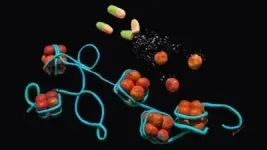(Press-News.org) A single, one-hour treatment that involves breathing in a mixture of oxygen and nitrous oxide -- otherwise known as laughing gas -- significantly improved symptoms in people with treatment-resistant depression, according to new data from researchers at Washington University School of Medicine in St. Louis and the University of Chicago.
In a phase 2 clinical trial, the researchers demonstrated that symptoms of depression improve rapidly following treatment with inhaled nitrous oxide. Further, they reported the benefits can last for several weeks.
The findings are published June 9 in the journal Science Translational Medicine.
"A large percentage of patients don't respond to standard antidepressant therapies -- the patients in this study had failed an average of 4.5 antidepressant trials -- and it's very important to find therapies to help these patients," said Charles R. Conway, MD, a professor of psychiatry at Washington University and one of the study's senior investigators. "That we saw rapid improvements in many such patients in the study suggests nitrous oxide may help people with really severe, resistant depression."
Conway, and the study's other co-senior investigator, Peter Nagele, MD, professor and chair of the Department of Anesthesia & Critical Care at the University of Chicago, and who previously had an appointment in the Department of Anesthesiology at Washington University School of Medicine, have been studying the potential of nitrous oxide as an antidepressant for the past decade.
Standard antidepressant drugs affect norepinephrine and serotonin receptors in the brain, yet they often take weeks to improve a person's symptoms. Nitrous oxide, however, interacts with different receptors on brain cells -- NMDA glutamate receptors -- and tends to improve symptoms within hours when effective.
"Our primary goals in this study were twofold: to determine whether a lower dose of nitrous oxide might be just as effective as doses we'd tested previously -- and it was for most patients -- and we also wanted to see how long the relief lasted," Nagele said. "In a proof-of-concept study several years ago, we assessed patients for 24 hours. In this study, we continued to assess them for two weeks, and most continued to feel better."
The study involved 24 patients. Each one received three treatments about one month apart. In one session, patients breathed gas for an hour that was half nitrous oxide, half oxygen. In a second treatment, the same patients breathed a solution that was 25% nitrous oxide. A third treatment, the placebo, involved breathing only oxygen, with no nitrous oxide.
"You can't really get a better comparison group than when you compare a person to himself or herself," Nagele said. "Serving as your own control is ideal. The alternative is studying the effects of a drug in two similar groups of people in which you either get one treatment or another. But the problem with that is that you need much larger numbers of patients before you really can draw conclusions."
The primary conclusions in this study were that nitrous oxide -- both at 25% and in a 50-50 mixture with oxygen -- improved depression in 17 of those study participants. The differences between a 25% mix and a 50% mix mainly involved how long the antidepressant effects lasted. Whereas the 50% dosage had greater antidepressant effects two weeks after treatment, the 25% dose was associated with fewer adverse events, the most common of which was feeling nauseated.
"Some patients experience side effects -- it's a small subset, but it's very real -- and the main one is that some people get nauseated," Conway said. "But in our study, only when people got the 50% dose did they experience nausea. When they received 25% nitrous oxide, no one developed nausea. And that lower dose was just about as effective as the higher dose at relieving depression."
Of the 20 people who completed all of the study's treatments and follow-up exams, 55% (11 of 20) experienced a significant improvement in at least half of their depressive symptoms, and 40% (eight of 20) were considered to be in remission -- meaning they no longer were clinically depressed -- after breathing a nitrous oxide solution for one hour.
Over the course of the entire study, having received both dose levels of nitrous oxide and the placebo treatment, some 85% (17 of 20) of the study participants experienced a significant enough improvement that their clinical classification moved at least one category -- for example, from severe to moderate depression.
Many of those in the study also took antidepressant drugs -- medications that, for the most part, had failed to relieve their depression -- but they were allowed to continue using those drugs while they participated in the study.
As many as one-third of those who take antidepressants don't improve. Nitrous oxide and ketamine, another anesthetic drug that interacts with NMDA glutamate receptors, recently have shown promise in those with treatment-resistant depression. Conway and Nagele believe both drugs may represent breakthroughs for people with treatment-resistant depression, but they believe nitrous oxide may have some practical advantages.
"One potential advantage to nitrous oxide, compared with ketamine, is that because it's a volatile gas, its anesthetic effects subside very quickly," Conway said. "It's similar to what happens in a dentist's office when people drive themselves home after getting a tooth pulled. After treatment with ketamine, patients need to be observed for two hours following treatment to make sure they are OK, and then they have to get someone else to drive them."
Nagele and Conway said it is important for scientists soon to conduct a large, multicenter study comparing the effects of ketamine and nitrous oxide to placebo.
INFORMATION:
Nagele P, et al. A phase 2 trial of inhaled nitrous oxide for treatment-resistant major depression. Science Translational Medicine, published online June 9, 2021.
This work was supported by a NARSAD award from the Brain & Behavior Research Foundation and the Taylor Family Institute for Innovative Psychiatric Research at Washington University School of Medicine.
Washington University School of Medicine's 1,500 faculty physicians also are the medical staff of Barnes-Jewish and St. Louis Children's hospitals. The School of Medicine is a leader in medical research, teaching and patient care, consistently ranking among the top medical schools in the nation by U.S. News & World Report. Through its affiliations with Barnes-Jewish and St. Louis Children's hospitals, the School of Medicine is linked to BJC HealthCare.
A new study unexpectedly identified tiny deposits of elemental copper and iron within the brains of two deceased people with Alzheimer's disease. The findings could help scientists better understand how these elemental metals, which were uncovered in the cores of amyloid plaques, contribute to neurodegenerative diseases and could point to a target for alternative Alzheimer's therapies. While enzymes and proteins containing positively charged copper and iron ions have been known to control key processes in the human brain, little has been known about how the organ mineralizes iron and copper, including the formation of elemental metallic nanoparticles, which ...
(Boston)--Should treatment of alcoholics be different based on gender? Yes, according to a new study that shows that alcoholic men and women respond differently to their disease resulting in different levels of brain activity and brain abnormalities. Research indicates that they distinguish facial expressions differently and that this is an important clue as to how treatment strategies might be tailored.
Chronic long-term Alcohol Use Disorder (AUD) or "alcoholism," is a harmful condition that has been associated with deficits in emotion and memory, including memory for the emotional expressions of faces. In addition to its effects on memory for facial emotions, AUD also has been associated with impairments ...
PSI researchers have developed a new tomography method with which they can measure chemical properties inside catalyst materials in 3-D extremely precisely and faster than before. The application is equally important for science and industry. The researchers published their results today in the journal Science Advances.
The material group of vanadium phosphorus oxides (VPOs) is widely used as a catalyst in the chemical industry. VPOs have been used in the production of maleic anhydride since the 1970s. Maleic anhydride in turn is the starting material for the ...
Widespread adoption of hydrogen-powered vehicles over traditional electric vehicles requires fuel cells that can convert hydrogen and oxygen safely into water - a serious implementation problem.
Researchers at the University of Colorado Boulder are addressing one aspect of that roadblock by developing new computational tools and models needed to better understand and manage the conversion process. Hendrik Heinz, an associate professor in the Department of Chemical and Biological Engineering, is leading the effort in partnership with the University of California Los Angeles. His team recently published new findings on the subject in Science Advances.
Fuel cell electric vehicles combine ...
A single one-hour treatment with nitrous oxide - also known as laughing gas - can relieve symptoms of treatment-resistant depression for several weeks, according to a phase 2 clinical trial involving 28 participants. By showing that a 25% concentration of the gas still has therapeutic effects, the results suggest that lower concentrations of nitrous oxide could be useful against depression in the clinic while bringing a lower risk of side effects. Inhaled nitrous oxide is commonly used as a sedative agent in dental and medical offices, but the gas has also attracted attention as a possible treatment for depression. A previous study showed that nitrous oxide had marked ...
New Curtin research has shown how a readily available, cheap and safe-to-use product found in the medicine cabinet of most homes could be the key to better ecological restoration practices with major benefits for the environment and agriculture.
The study revealed that aspirin, which naturally occurs in the bark of the willow tree and other plants, can improve the survival of grass species important for ecological restoration and sustainable pasture when applied in a seed coating.
Lead researcher Dr Simone Pedrini from the ARC Centre for Mine Site Restoration in Curtin's School of Molecular and Life Sciences, said salicylic acid has been used for its medicinal properties for more than 4000 years and its modern synthetic version, acetylsalicylic acid, or aspirin, is one ...
Our genetic material is stored in our cells in a specific way to make the meter-long DNA molecule fit into the tiny cell nucleus of each body cell. An international team of researchers at the Max Planck Institute for Biology of Ageing, the CECAD Cluster of Excellence in Ageing research at the University of Cologne, the University College London and the University of Michigan have now been able to show that rapamycin, a well-known anti-ageing candidate, targets gut cells specifically to alter the way of DNA storage inside these cells, and thereby promotes gut health and longevity. This effect has been observed in flies and mice. The researchers believe this finding will open up new possibilities for targeted therapeutic interventions ...
BOSTON - A new analysis by researchers at Massachusetts General Hospital (MGH) offers a novel perspective on the disproportionate impact that COVID-19 has had on people of color, low-income populations, and other structurally disadvantaged groups. Their findings, published in a research letter to the END ...
For decades, physicians and dieticians have urged people to limit their intake of high fat foods, citing links to poor health outcomes and some of the leading causes of death in the U.S., such as diabetes, heart disease and cancer.
According to the Centers for Disease Control and Prevention, dietary components high in saturated fats such as red meat are thought to be risk factors for colon cancer. Diet is thought to strongly influence the risk of colorectal cancer, and changes in food habits might reduce up to 70% of this cancer burden.
Other known epidemiological risk factors are family history, inflammatory bowel disease, ...
Watching what was happening around the world in early 2020, University of California San Diego School of Medicine researchers knew their region would likely soon be hit with a wave of patients with COVID-19, the infection caused by the coronavirus SARS-CoV-2. They wondered how the virus persists on surfaces, particularly in hospitals, and they knew they had only a small window of time to get started if they wanted to capture a snapshot of the "before" situation -- before patients with the infection were admitted.
After a call late one Sunday night, a team assembled in the ...




